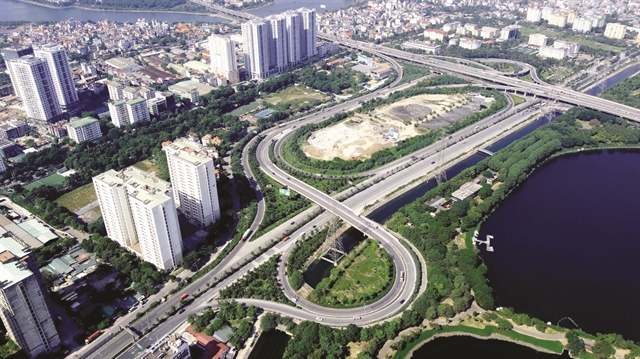 Economy
Economy

 |
| A dragon model on Hàng Mã Street, Hà Nội. Forecasts are optimistic for the Vietnamese economy in the Year of the Dragon. — VNA/VNS Photo Hoàng Hiếu |
HÀ NỘI — Unleashing internal forces to create new growth drivers is critical for Việt Nam to make breakthrough economic developments in a volatile global landscape.
The Vietnamese Government in Resolution 01 dated January 5 on solutions to promote socio-economic development has set the GDP growth target at 6-6.5 per cent this year, after 2023 growth slowed to 5.05 per cent on weak global demand.
Despite missing the Government target of 6.5 per cent, Vietnamese economic growth is positive on the backdrop of a global slowdown and rising uncertainty, making the country one of the fastest growing economies in the world.
“As FDI inflows continue to add production capacity, Việt Nam’s manufacturing sector is experiencing the green shoots of a rebound, bringing opportunities for its exports.”
HSBC Global Research
Impressive recoveries in the second half of 2023 have provided a firm foundation for a stronger rebound in 2024. The outlooks are mostly rosy.
“Việt Nam’s economy is on a firm recovery track. Despite the rough waters, Việt Nam ended 2023 relatively optimistic that 2024 is likely to be the year the country emerges strongly from mounting challenges,” wrote the report “Việt Nam at a glance” by HSBC Global Research earlier this month.
Keeping a sanguine economic outlook for Việt Nam, HSBC expected growth to accelerate to 6 per cent in 2024.
“As Việt Nam bids farewell to the challenges posed by the Year of the Cat, it is ushering in a more hopeful Year of the Dragon,” HSBC wrote. “As FDI inflows continue to add production capacity, Việt Nam’s manufacturing sector is experiencing the green shoots of a rebound, bringing opportunities for its exports.”
The Asian Development Bank (ADB) in its latest Asian Development Outlook keeps its forecast for the Vietnamese economy in 2024 at 6 per cent, on recovery in the external environment and regained momentum from domestic growth drivers.
Standard Chartered’s forecast is even more robust with GDP growth at 6.7 per cent in 2024 on the recovery of retail sales, industrial production and trade, while noting that headwinds to global trade still pose a risk.
The Central Institute for Economic Management has predicted Việt Nam’s economic growth at 6.48 per cent this year in the best scenario in which the global economy expands at 3.2 per cent. In another scenario, the GDP growth is projected at 6.13 per cent if the global economic expansion is 2.9 per cent.
"Although 2024 might not be an easy year as both the Vietnamese and global economy will continue to face persistent headwinds, Việt Nam has built up momentum from innovation, institutional reforms and economic restructuring," the think tank’s Director Trần Thị Hồng Minh said. “Hastening reforms will create room for stronger growth,” she stressed.
Don’t forget the risks
Despite a rosy picture, uncertain global economic environment poses significant risks, underscoring the need for Việt Nam to seek new growth drivers, especially from its internal strength.
The January 2024 Chief Economists Outlook published on January 15th by the World Economic Forum highlights that the uncertainty which dominated the outlook over the last year continues to cloud the near-term economic picture, as the global economy grapples with headwinds from tight financial conditions and geopolitical rifts while adapting to rapid advancements in generative AI.
“Global economic prospects remain subdued and fraught with uncertainty. Although 56 per cent of chief economists expect the global economy to weaken over the next year, 20 per cent foresee unchanged conditions and nearly a quarter expect stronger conditions. The economic backdrop is marked by protracted weakness in global growth and widening divergence,” the report notes.
In addition, geopolitical rifts compound uncertainty. “Global economic developments are being profoundly shaped by deepening fragmentation. Around 69 per cent of chief economists are expecting the pace of geoeconomic fragmentation to accelerate this year.”
The Global Economic Prospects, a World Bank Group flagship report published in January, highlights that global growth is expected to slow to 2.4 per cent in 2024, the third consecutive year of deceleration, reflecting the lagged and ongoing effects of tight monetary policies to rein in decades-high inflation, restrictive credit conditions and anaemic global trade and investment.
“Downside risks to the outlook include an escalation of the recent conflict in the Middle East and associated commodity market disruptions, financial stress amid elevated debt and high borrowing costs, persistent inflation, weaker-than-expected activity in China, trade fragmentation and climate-related disasters,” the report pointed out.
“For the world, 2024 is still going to be a challenging year. The Vietnamese economy is going to do probably a little bit better than last year but unfortunately, I don’t think it’s going to grow at the rates we saw before the COVID-19 pandemic at 6.5-7 per cent,” Dorsati H. Madan, Senior Country Economist Macroeconomics, Trade and Investment, World Bank, was quoted as saying.
Renew drivers for a green future
 |
| Robust infrastructure significantly helps drive economic growth. Besides traditional growth drivers including export, investment and consumption, Việt Nam should unleash new forces from innovation, high technology, green transition and digital transformation. — VNA/VNS Photo Huy Hùng |
In the context that traditional growth drivers of the Vietnamese economy have not fully regained momentum, it is vital for the country to look at its internal strength to build up new driving forces.
Three major export markets of Việt Nam, including the US, the EU and China, are predicted to improve in a very moderate way or even continue to slow down, meaning that there is not going to be a major increase in exports, the drivers should be on the domestic side, according to Dorsati.
Domestic consumption and domestic private investment could be good contributors, she said, adding that the Government should provide supportive fiscal policies such as public investment to support aggregate demand.
"It is really important for the Vietnamese Government to consider adopting policies to recover the real estate market, which is in a slump and affecting private investment," she added.
Regarding agriculture which is a spotlight of the Vietnamese economy last year, Dorsati stressed that agriculture had been a steady contributor to economic growth, but its contribution remained modest, except for job creation in rural areas. The sector could blossom only with the acceleration in technology application, the development of agri-business and the improvement in productivity.
It was difficult to rely only on the external factor or export to create breakthrough, Hoàng Văn Cường, Member of the National Assembly Finance – Budget Committee, said. “Unleashing internal force and turning it into new growth drivers for the economy is vital,” he said.
Prompt actions should be taken to take advantage of opportunities arising from new trends such as green transition and digital transformation which would create fundamental changes in the structure of the economy, Cường stressed. “2024 will provide unprecedented opportunities for Việt Nam to climb up the global value chain. The Government and businesses need to take prompt action.”
According to Cấn Văn Lực, a member of the National Monetary and Financial Policy Advisory Council, new driving forces will be unleashed if institutional improvement is accelerated, including the adoption of the amended Law on Land and Law on Credit Institutions, which will, together with other laws passed in 2023, create an important legal foundation for the property market, finance – banking market and labour market to develop more stably and sustainably.
Besides, it is necessary to develop the legal framework for new economic and business models, promote the digital economy, circular economy and energy transition.
Stressing that public investment would remain a major driver of the Vietnamese economy this year, he said that it was a must to speed up the disbursement and increase the efficiency of the capital.
Promoting private investment was also an important solution, he said, adding that new forces would emerge from the development of digital economy, science and technology, green growth, energy transition, labour productivity and institutional reforms, especially in the context that Việt Nam was adopting the minimum 15 per cent corporate tax rate for multinational corporations starting from the beginning of this year.
Nguyễn Quốc Việt, Deputy Director of the Việt Nam Institute for Economic and Policy Research, said that the next phase of reforms should focus on facilitating investments by the domestic enterprises and encourage them to invest in innovations and technologies to drive growth.
Looking back to 2023, with the highest number of enterprises leaving the market and below-expectation credit growth, Đậu Anh Tuấn, Head of the Legal Department of the Việt Nam Chamber of Commerce and Industry, said that the focus should be on creating the most favourable conditions for enterprises through institutional reforms and improving the business environment – a key to growth.
In a global context of volatility and uncertainty, Việt Nam’s position is strengthened in the international arena, providing a “golden opportunity” to hasten reform, solve the internal problems of the economy and unleash internal strength to create new drivers.
Together with economic restructuring, digital economy development, circular economy development and green growth, the deeper participation in the global supply chain of sectors such as semiconductor, high technology and renewable energy would create new drivers and become a pillar for the country’s rapid and sustainable development, former Director of the General Statistics Office Nguyễn Bích Lâm said.
Lâm also stressed the importance of an export-based growth strategy in the reshaping of the global supply chain, adding that exports would remain the major driver in the next two decades. The export strategy must be aligned with the global new trends of green growth, carbon reduction and high technology. — VNS




